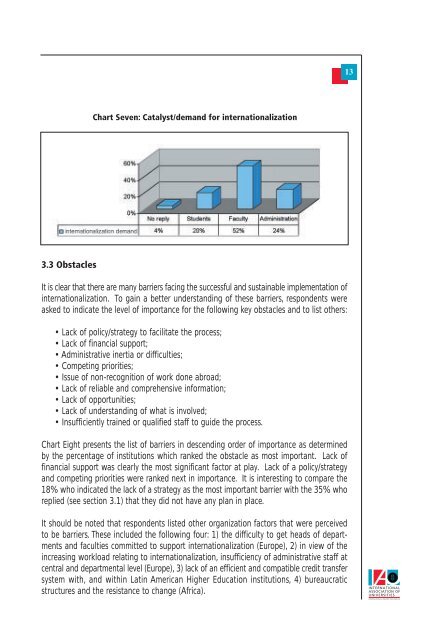Executive summary - IAU 1st Global Survey (2003)
You also want an ePaper? Increase the reach of your titles
YUMPU automatically turns print PDFs into web optimized ePapers that Google loves.
13<br />
Chart Seven: Catalyst/demand for internationalization<br />
3.3 Obstacles<br />
It is clear that there are many barriers facing the successful and sustainable implementation of<br />
internationalization. To gain a better understanding of these barriers, respondents were<br />
asked to indicate the level of importance for the following key obstacles and to list others:<br />
• Lack of policy/strategy to facilitate the process;<br />
• Lack of financial support;<br />
• Administrative inertia or difficulties;<br />
• Competing priorities;<br />
• Issue of non-recognition of work done abroad;<br />
• Lack of reliable and comprehensive information;<br />
• Lack of opportunities;<br />
• Lack of understanding of what is involved;<br />
• Insufficiently trained or qualified staff to guide the process.<br />
Chart Eight presents the list of barriers in descending order of importance as determined<br />
by the percentage of institutions which ranked the obstacle as most important. Lack of<br />
financial support was clearly the most significant factor at play. Lack of a policy/strategy<br />
and competing priorities were ranked next in importance. It is interesting to compare the<br />
18% who indicated the lack of a strategy as the most important barrier with the 35% who<br />
replied (see section 3.1) that they did not have any plan in place.<br />
It should be noted that respondents listed other organization factors that were perceived<br />
to be barriers. These included the following four: 1) the difficulty to get heads of departments<br />
and faculties committed to support internationalization (Europe), 2) in view of the<br />
increasing workload relating to internationalization, insufficiency of administrative staff at<br />
central and departmental level (Europe), 3) lack of an efficient and compatible credit transfer<br />
system with, and within Latin American Higher Education institutions, 4) bureaucratic<br />
structures and the resistance to change (Africa).





